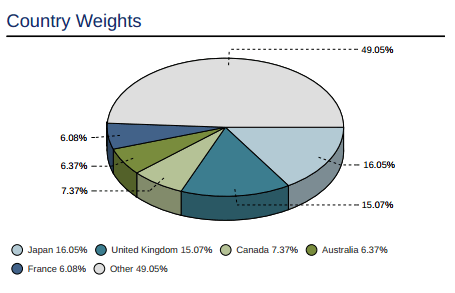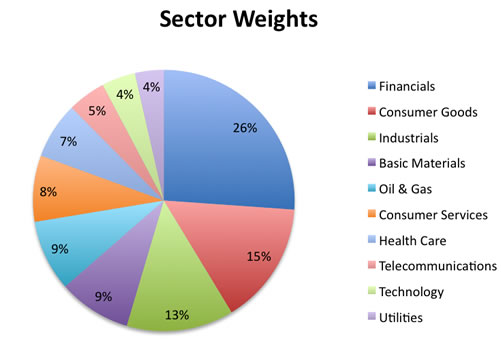 (See also: Vanguard Total Stock Index Fund Review)
(See also: Vanguard Total Stock Index Fund Review)
The Vanguard Total International Stock Index Fund is available both as a mutual fund (VGTSX, VTIAX) and an ETF (VXUS). Across all shares classes, there is currently around $90 billion dollars invested in this fund, making it one of the top 10 largest funds in the world. As the name suggests, this fund attempts to include all the investable companies from every single country in the world outside the US. From Indonesia to Morocco, from Luxembourg to Hong Kong. It also includes small-cap, mid-cap, and large-cap companies, unlike many other “total international” index funds. Such a wide coverage area makes this fund very fascinating. Let’s take a look inside.
Market Capitalization Weighting
The Vanguard Total International Stock Index Fund is currently transitioning from tracking the MSCI ACWI ex USA IMI Index to the FTSE Global All Cap ex US Index (say that 5 times fast!). The two indexes are very similar; the change is primarily an attempt to avoid the higher licensing costs charged by MSCI. (The good news is that Vanguard has a great track record of passing on such savings onto their fund investors.) These are both market-cap weighted indexes, which means that the amount of each stock held is directly proportional to the total market value of the company (regardless of the country). The following are the countries included (note that FTSE has Korea as a developed market):
Developed Markets countries include: Australia, Austria, Belgium, Canada, Denmark, Finland, France, Germany, Greece, Hong Kong, Ireland, Israel, Italy, Japan, Netherlands, New Zealand, Norway, Portugal, Singapore, Spain, Sweden, Switzerland and the UK.
Emerging Markets countries include: Brazil, Chile, China, Colombia, Czech Republic, Egypt, Hungary, India, Indonesia, Korea, Malaysia, Mexico, Morocco, Peru, Philippines, Poland, Russia, South Africa, Taiwan, Thailand and Turkey.
Taken from the MSCI factsheet [pdf], below is how the market-cap weighting system ends up splitting things up by country. Japan, UK, Canada, Australia, and France are roughly half of the fund, with everyone else making up the other half. In terms of regions, it’s roughly 40% Developed Europe, 30% Developed Pacific, 20% Emerging Markets, and 10% North America.

Taken from the FTSE factsheet, here is current sector weighting of the index:

The MSCI index currently has 5,992 constituents. The largest company is worth over $230 Billion, the smallest is worth only $6 million, and the median is $610 million. Meanwhile, FTSE has 5,394 constituents ranging from $230 Billion (Nestle) to $15 million, with a median value of $814 million. While the two are very similar, it would appear that the FTSE index has slightly narrower coverage of smaller companies. However, Vanguard doesn’t always follow the indexes down to the letter, as right now the fund has 6,176 holdings.
Owning the Haystack
As is the case with holding a Total US index fund, owning a piece of every single stock that is publicly-traded is a powerful thing. Back in 1997, Apple Inc. had a market cap of around $2 billion. Today, the market cap is over $400 billion. That’s 200 times larger, or a 20,000% return over just 16 years. Instead of trying identify ahead of time that little company that will be the next Apple, you may already own it. To paraphrase a well-known quote from Vanguard founder Jack Bogle:
Don’t look for the needle in the haystack. Buy the entire haystack.
You may not make a 20,000% return, but you will own the result of whatever innovation comes in the future. A company in Finland make figure out clean nuclear energy, or a Singaporean company could invent a way to create cheap, clean water in remote locations. You never know.
Another benefit that results from all this is minimal trading and thus very little turnover. If a company rises (or drops) in value, then with market-cap weighting it should be a larger (or smaller) part of the portfolio and there is no need to buy or sell any shares. Since you own the whole haystack, you don’t even have to worry about a company going from “emerging” to “developed”. This means the fund is very tax-efficient and distributes very little taxable capital gains. In a taxable account, this improves your after-tax returns and lets compounding do its thing.
Fund Management Expenses
Since 2/28/2013, the annual expense ratio of both the ETF (no minimum) and Admiral share classes ($10,000 minimum) of the Vanguard Total International Stock Index Fund is 0.16%. So for every $10,000 invested, Vanguard charges a total of $16 a year to manage this basket of stocks. There is no way an individual could replicate the underlying holding themselves for such a price. The Investor class shares have an expense ratio of 0.22%. Specifically, these fund expenses are taken out of the fund’s net asset value (NAV) a tiny bit each day (fractions of a penny per share).
Final Thoughts
By representing the entire world excluding the USA in a complete, efficient, and low-cost manner, the Vanguard Total International Stock Index Fund is a great core holding and a perfect complement to the Vanguard Total US Stock Index Fund. Held together, you then own a haystack of all the companies around the world that can be reasonably be invested in based on liquidity and availability. If you wanted to hold these two fund in market-cap weighting as well, currently that would be a 47/53 Non-US/US split. (I just do 50/50.)
Owning a competing index fund that also tracks a broad “world-minus-USA” international index using market-cap weighting with a low expense ratio will likely give you similar results. However, I give a slight preference to Vanguard due to (1) their “at-cost” client-ownership structure helps to ensure that costs will stay low, and (2) their experience and skill at indexing.
Disclosures: VGTSX/VTIAX/VXUS is a cornerstone of my portfolio, and I expect it to stay that way for the foreseeable future.
 The Best Credit Card Bonus Offers – 2025
The Best Credit Card Bonus Offers – 2025 Big List of Free Stocks from Brokerage Apps
Big List of Free Stocks from Brokerage Apps Best Interest Rates on Cash - 2025
Best Interest Rates on Cash - 2025 Free Credit Scores x 3 + Free Credit Monitoring
Free Credit Scores x 3 + Free Credit Monitoring Best No Fee 0% APR Balance Transfer Offers
Best No Fee 0% APR Balance Transfer Offers Little-Known Cellular Data Plans That Can Save Big Money
Little-Known Cellular Data Plans That Can Save Big Money How To Haggle Your Cable or Direct TV Bill
How To Haggle Your Cable or Direct TV Bill Big List of Free Consumer Data Reports (Credit, Rent, Work)
Big List of Free Consumer Data Reports (Credit, Rent, Work)
Nice review. I currently don’t have much to invest but what I do go all into Vanguard Total Stock. At some point I’m looking to do what you do 50/50 Total Stock US and Total International with maybe some of the REIT index fund since I own no real estate.
A brief comparison with VEU would have been appropriate in this article, as VEU is an older and probably more well-known etf.
We’ve kind of talked about this before, Jonathan, but why do you think Vanguard hasn’t come out with a full-replication market-weighted fund for the world market (i.e., Total US + Total Intl)? They already have VTWSX/VT, but as you and I both know, that fund lacks diversification. They always recommend for people to told Total US + Total Intl, and it’s even what the equity portions of their Target Date funds are comprised of. However, I’ve noticed that they never recommend for Total US + Total Intl to be held in proportion to market caps. They always recommend overweighting Total US (which is a mistake, IMO). Maybe that’s the reason for the lack of a Total US + Total Intl fund.
@Don – I thought about that, but I didn’t know if VEU was really that much better known outside of index fund geeks. The review was getting a big long too. 🙂 As you probably know, VTI + VXUS are basically analogous, while VEU lacks small-caps. More here:
https://www.mymoneyblog.com/build-a-complete-stock-portfolio-with-just-two-etfs-vanguard-total-us-vti-and-total-international-vxus.html
Specifically this graphic (certain numbers like expense ratio data are out of date):
(Source, brighter red text is added by me)
@Andrew – I also am not sure why VT isn’t just a wrapper for VTI and VXUS. It’d be cheaper and offer more stocks. I think that Vanguard makes so many different products due to their desire to satisfy individual retail investors as well as institutional and professional money managers. Do that many individuals really buy MGC?
I think reasonable people can disagree on the US/non-US split, as most Target date funds appear to overweight US stocks. I believe that is due to past performance of US stocks. I too am happy with my 50/50 because I think it looks forward as opposed to looking backward.
thanks for the right up. i am still trying to determine my allocation among several vanguard funds. i am looking for some mix of total world, total us, some emerging market and some bond.
do you think with total world, one could simply ignore a more specific emerging component? do you think it does that job well enough? also, do you feel there is any preference towards etf or fund?
I had similar thinking to you, Jonathan, when I allocated by domestic/international split, but I opted for 60% domestic, 40% international. For better or worse, I gave the slight edge to domestic because both have similar expected return before expenses, but the domestic expenses are lower.
@JP – Most likely VT isn’t a wrapper for VTI and VXUS because adopting a “fund of funds” structure would render it ineligible for the foreign tax credit.
If I recall correctly, several years back VGTSX began transitioning from a “fund of funds” structure for that very reason. Today it holds individual equities (like VFWIX).
@skylog – Yes, I think that you could just do a Total World or Total International. Emerging markets is already 20% of Total International. ETF or fund depends on a few different factors, I wrote a post about it somewhere…
@Dan – Don’t see anything wrong with that!
@Pete – Very good point.
@jonathan ping – thank you. that is the way i was leaning, but i just need to finally just sit down and look over all the options in detail. yes, i actually thought so… i will search for it. obviously, lower fees would be one concern, having to factor admiral versus normal shares as well as the etf option. etf compostion…etc…i’ll search. thanks again.